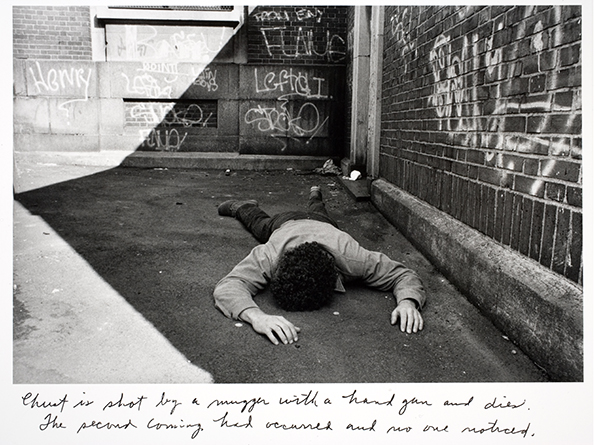The Davis Museum is closed for Wellesley College’s winter break. Please join us at our spring opening celebration on February 5, 2026, at 4 pm.
Christ in New York

Duane Michals, Christ is sold on Television by a Religious Hypocrite from the series Christ in New York, 1981. Gelatin silver print, sheet: 8 in. x 10 in. (20.3 cm x 25.4 cm); image: 5 in. x 7 1/2 in. (12.7 cm x 19 cm). Museum purchase, 1984.31.1-.6
Christ is sold on Television by a Religious Hypocrite is part of a series of photographs by Duane Michals entitled Christ in New York. A largely self-taught photographer, Michals took pride in rejecting many conventions of the art world. When, in 1974, he became frustrated with the inadequacy of his images as a means of communicating his ideas, he began to write on his photographs to describe what remained unseen. The words scrawled across the bottom of each photo in the series Christ in New York underscore the bitter irony of each situation.
Upon first viewing Christ in New York, we immediately realize that these are staged photographs. Christ is represented stereotypically, as if through the eyes of a child, as a bearded white man with a glowing halo. He is stiffly posed in each photograph, with his face almost expressionless and his arms often awkwardly stuck to his side, or outstretched in a pose reminiscent of his death on the cross. His crude halo and the theatricality of the models’ poses immediately remove any illusion of photographic reality, so that as viewers, we can move on to consider—what was Michals’ intent in staging these scenes?
Michals’ use of the figure of Christ in this series, as a symbol of purity, sacrifice, and innocence, makes the violence he is juxtaposed next to all the more shocking. The sense that Christ is ignored, denigrated, and even trapped in these situations is heightened by the compositional elements of each photograph. In Christ is sold on Television by a Religious Hypocrite, only Christ’s upper body is shown, cut off and boxed in by three images of the evangelist, who is shown standing next to Christ, on the screen of the television, and on the screen of the video camera. Throughout the whole series, Christ’s figure is trapped in some way, often pushed into a corner by tables, walls, and the blows of attackers. When he lies alone in an alleyway in Christ is Shot by a Mugger with a Hand Gun and Dies, his figure is tightly enclosed in the space created by a brick wall and the sharp diagonal lines of a building’s shadow.
Christ in New York is a series born out of Michals’ anger around the hot-topic issues of the 1980s, most of which are still relevant today. Michals, a gay man, grew up in an intensely religious Catholic community, where he says being gay was not recognized as an option. By recontextualizing the figure of Christ as someone who defends homosexuals and cries over the dead bodies of women who have had illegal abortions, Michals is making a clear political statement against the hypocrisy of some Christian communities, while forcefully reminding us of the pervasive acts of violence in the modern world.
Sarah Heveron-Smith ’12
Technology Intern, Summer 2012